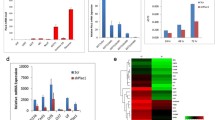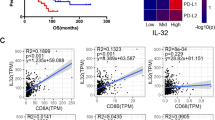Abstract
Interleukin-33 (IL-33) is a member of the IL-1 cytokine family, primarily known as a mediator of the humoral immune response. It provides protection of barrier tissues and participates in the development of a range of diseases. This cytokine promotes carcinogenesis by induction of proliferation and survival of cancer cells, remodeling of the tumor microenvironment, and promoting immunosuppressive conditions. Elevated levels of IL-33 were observed in many types of cancers. This elevation correlates with a poor prognosis, making IL33 a promising target for cancer immunotherapy. The mechanisms of IL-33 expression regulation in human tumor cells are not well understood. Here, we show that that expression of IL-33 in breast and lung cancer cell lines depends, at least in part, on the activity of the SP1 and FOXA1 transcription factors. Increases in the activity of these transcription factors may be responsible for elevated levels of IL-33 and subsequent tumor progression.





Similar content being viewed by others
REFERENCES
Aggarwal B.B., Vijayalekshmi R. V, Sung B. 2009. Targeting inflammatory pathways for prevention and therapy of cancer: Short-term friend, long-term foe. Clin. Cancer Res. 15 (2), 425–430.
Leibovici J., Itzhaki O., Huszar M., Sinai J. 2011. The tumor microenvironment: Part 1. Immunotherapy. 3, 1367–1384.
Kumar J., Surh Y. 2008. Inflammation: Gearing the journey to cancer. Mutat. Res. 659, 15–30.
Liew F.Y., Pitman N.I., McInnes I.B. 2010. Disease-associated functions of IL-33: The new kid in the IL-1 family. Nat. Rev. Immunol. 10, 103–110.
Gao X., Wang X., Yang Q., Zhao X., Wen, WenJiang J., Wu C., Zhang X. 2014. Tumoral expression of IL-33 inhibits tumor growth and modifies the tumor microenvironment through CD8+ T and NK cells. J. Immunol. 194 (1), 438-445.
Kim J.Y., Lim S., Kim G., Yun H.J., Ahn S., Choi H.S. 2014. Interleukin-33/ST2 axis promotes epithelial cell transformation and breast tumorigenesis via upregulation of COT activity. Oncogene. 34 (38), 4928‒4938.
Chen S.-F., Nieh S., Jao S.-W., Wu M.-Z., Liu C.-L., Chang Y.-C., Lin Y.-S. 2013. The paracrine effect of cancer-associated fibroblast-induced interleukin-33 regulates the invasiveness of head and neck squamous cell carcinoma. J. Pathol. 231, 180–189.
Jovanovic I.P., Pejnovic N.N., Radosavljevic G.D., Pantic J.M., Milovanovic M.Z., Arsenijevic N.N., Lukic M.L. 2014. Interleukin-33/ST2 axis promotes breast cancer growth and metastases by facilitating intratumoral accumulation of immunosuppressive and innate lymphoid cells. Int. J. Cancer. 134, 1669–1682.
Xiao P., Wan X., Cui B., Liu Y., Qiu C., Rong J., Zheng M., Song Y., Chen L., He J., Tan Q., Wang X., Shao X., Liu Y., Cao X., Wang Q. 2016. Interleukin 33 in tumor microenvironment is crucial for the accumulation and function of myeloid-derived suppressor cells. Oncoimmunology. 5, e1063772.
Wang C., Chen Z., Bu X., Han Y., Shan S., Ren T., Song W. 2016. IL-33 signaling fuels outgrowth and metastasis of human lung cancer. Biochem. Biophys. Res. Commun. 479, 461–468.
Hu L., Fu Y., Zhang D., Zhang J. 2013. Serum IL-33 as a diagnostic and prognostic marker in non-small cell lung cancer. Asian Pacific J. Cancer Prev. 14, 2563–2566.
Liu J., Shen J., Hu J., Huang W., Zhang G. 2014. Significance of interleukin-33 and its related cytokines in patients with breast cancers. Front. Immunol. 5, 141.
Liu X., Zhu L., Lu X., Bian H., Wu X., Yang W., Qin Q. 2014. IL-33/ST2 pathway contributes to metastasis of human colorectal cancer. Biochem. Biophys. Res. Commun. 453, 486–492.
Yu X.X., Hu Z., Shen X., Dong L.Y., Zhou W.Z., Hu W.H. 2015. IL-33 promotes gastric cancer cell invasion and migration via ST2–ERK1/2 pathway. Dig. Dis. Sci. 60, 1265–1272.
Tsuda H., Komine M., Tominaga S., Ohtsuki M. 2017. Identification of the promoter region of human IL-33 responsive to induction by IFNγ. J. Dermatol. Sci. 85, 137–140.
Gorbacheva A., Korneev K., Kuprash D., Mitkin N. 2018. The risk G allele of the single-nucleotide polymorphism rs928413 creates a CREB1-binding site that activates IL33 promoter in lung epithelial cells. Int. J. Mol. Sci. 19, 2911.
Hasson S.A., Kane L.A., Yamano K., Huang C.H., Sliter D.A., Buehler E., Wang C., Heman-Ackah S.M., Hessa T., Guha R., Martin S.E., Youle R.J. 2013. High-content genome-wide RNAi screens identify regulators of parkin upstream of mitophagy. Nature. 504, 291–295.
Bommer G.T., MacDougald O.A. 2011. Regulation of lipid homeostasis by the bifunctional SREBF2-miR33a locus. Cell Metab. 13, 241–247.
Moon Y.A., Liang G., Xie X., Frank-Kamenetsky M., Fitzgerald K., Koteliansky V., Brown M.S., Goldstein J.L., Horton J.D. 2012. The Scap/SREBP pathway is essential for developing diabetic fatty liver and carbohydrate-induced hypertriglyceridemia in animals. Cell Metab. 15, 240–246.
Park H.J., Georgescu S.P., Du C., Madias C., Aronovitz M.J., Welzig C.M., Wang B., Begley U., Zhang Y., Blaustein R.O., Patten R.D., Karas R.H., Van Tol H.H., Osborne T.F., Shimano H., et al., 2008. Parasympathetic response in chick myocytes and mouse heart is controlled by SREBP. J. Clin. Invest. 118, 259–271.
Hsu T.I., Wang M.C., Chen S.Y., Yeh Y.M., Su W.C., Chang W.C., Hung J.J. 2012. Sp1 expression regulates lung tumor progression. Oncogene. 31, 3973–3988.
Wang R., Xu J., Xu J., Zhu W., Qiu T., Li J., Zhang M., Wang Q., Xu T., Guo R., Lu K., Yin Y., Gu Y., Zhu L., Huang P., et al., 2018. MiR-326/Sp1/KLF3: a novel regulatory axis in lung cancer progression. Cell Prolif. 52 (2), e12551.
Huang C., Yonemura Y., Xiong B., Liu J., Yang X. 2018. Expression and prognosis analyses of forkhead box A (FOXA) family in human lung cancer. Gene. 685, 202–210.
Zhao Y., Ma J., Fan Y., Wang Z., Tian R., Ji W., Zhang F., Niu R. 2018. TGF-β transactivates EGFR and facilitates breast cancer migration and invasion through canonical Smad3 and ERK/Sp1 signaling pathways. Mol. Oncol. 12, 305–321.
Wang H., Liu X.S., Wang G., Zhang F., Meyer C.A., Fei T. 2013. A systematic approach identifies FOXA1 as a key factor in the loss of epithelial traits during the epithelial-to-mesenchymal transition in lung cancer. BMC Genomics. 14, 680.
Li J., Zhang S., Zhu L., Ma S. 2018. Role of transcription factor FOXA1 in non-small cell lung cancer. Mol. Med. Rep. 17, 509–521.
Schrijver W., Schuurman K., van Rossum A., Droog M., Jeronimo C., Salta S., Henrique R., Wesseling J., Moelans C., Linn S.C., van den Heuvel M., van Diest P., Zwart W. 2018. FOXA1 levels are decreased in pleural breast cancer metastases after adjuvant endocrine therapy, and this is associated with poor outcome. Mol. Oncol. 12, 1884–1894.
Kaplan R.N., Riba R.D., Zacharoulis S., Bramley A.H., Vincent L., Costa C., MacDonald D.D., Jin D.K., Shido K., Kerns S.A., Zhu Z., Hicklin D., Wu Y., Port J.L., Altorki N., et al., 2005. VEGFR1-positive haematopoietic bone marrow progenitors initiate the pre-metastatic niche. Nature. 438, 820–827.
Yang Z., Gao X., Wang J., Xu L., Zheng Y., Xu Y. 2018. Interleukin-33 enhanced the migration and invasiveness of human lung cancer cells. Onco. Targets. Ther. 11, 843–849.
Wang K., Shan S., Yang Z., Gu X., Wang Y., Wang C., Ren T., Wang K., Shan S., Yang Z., Gu X., Wang Y., Wang C., Ren T. 2017. IL-33 blockade suppresses tumor growth of human lung cancer through direct and indirect pathways in a preclinical model. Oncotarget. 8, 68571–68582.
Hu H., Sun J., Wang C., Bu X., Liu X., Mao Y., Wang H. 2017. IL-33 facilitates endocrine resistance of breast cancer by inducing cancer stem cell properties. Biochem. Biophys. Res. Commun. 485, 643–650.
Rheinbay E., Parasuraman P., Grimsby J., Tiao G., Engreitz J.M., Kim J., Lawrence M.S., Taylor-Weiner A., Rodriguez-Cuevas S., Rosenberg M., Hess J., Stewart C., Maruvka Y.E., Stojanov P., Cortes M.L., et al., 2017. Recurrent and functional regulatory mutations in breast cancer. Nature. 547, 55–60.
Funding
The study was supported by the Russian Foundation for Basic Research (project no. 18-34-01004).
Author information
Authors and Affiliations
Corresponding author
Ethics declarations
The authors declare that they have no conflict of interest.
This study does not contain any research involving humans or animals as research objects.
Rights and permissions
About this article
Cite this article
Gorbacheva, A.M., Kuprash, D.V. & Mitkin, N.A. Regulation of IL33 Gene Expression by SP1 and Foxa1 in Breast and Lung Cancer Cells. Mol Biol 55, 92–101 (2021). https://doi.org/10.1134/S0026893321010064
Received:
Revised:
Accepted:
Published:
Issue Date:
DOI: https://doi.org/10.1134/S0026893321010064




